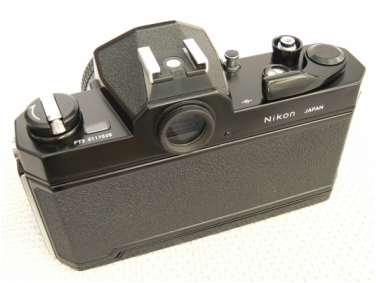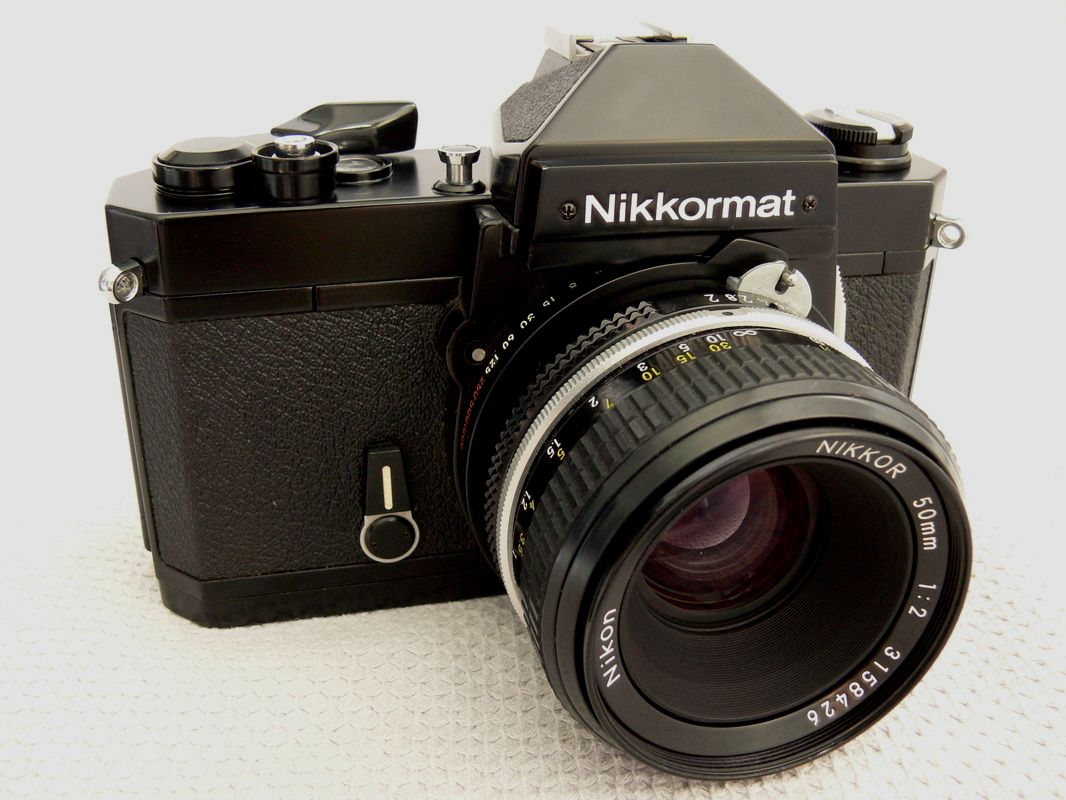|
Updated Aug. 30, 2021 In 1962, Nikon decided to take the plunge into the amateur enthusiast SLR market with a new model, the Nikkorex F. From 1959 to this point, they only had the solitary, professional-oriented, Nikon F in their SLR lineup. The price of the F put it out of reach of the average 35mm photo enthusiast. In the meantime, Minolta and Pentax were cleaning up in the sales department in the amateur market, with Pentax having approximately four times and Minolta ten times the overall sales of Nikon in the whole interchangeable lens SLR market in 1962. This would prove to be a very consequential decision by Nikon, one that would impact their growth for decades to come. And not just in camera body sales. However, the Nikkorex F would fail to achieve Nikon's goal of successfully breaking into the enthusiast market. So it was back to the old drawing board... The major appeal of an SLR is the fact that the photographer can switch (interchange) between different lenses (from ultra wide-angle to super telephoto) depending on the situation. This versatility is unmatched in the photographic world. It also means that manufacturers can get repeat business from the SLR buyer, in the form of filling out their personal lens arsenal. The more SLR bodies a camera maker sells, the greater the opportunity to sell more lenses (which is where the greatest potential profits lie). So, it was the combination of the early success of Minolta and Pentax in the enthusiast market and the desire to sell more lenses and accessories that drove Nikon to diversify its SLR lineup in 1962. There was only one problem: the Nikkorex F was a dud (less-than-stellar quality compared to Nikon's usual standard). Nikon had actually subcontracted with another camera manufacturer (Mamiya) to build the Nikkorex cameras (there were also a few fixed-lens Nikkorex models). The two companies had very different approaches to design and production techniques, so it seems that Mamiya (who later built some very good 35mm SLRs and some of the best medium format cameras and lenses ever) was not the best choice for a collaboration with Nikon at that time. Nevertheless, Nikon was able to learn from the Nikkorex fiasco and applied the lessons to its next attempt at the enthusiast market. Learning From Failure 1964 proved to be pivotal in the development of the next Nikon enthusiast-targeted SLR. Minolta and Pentax still maintained their dominance of the overall market with approximately eight and four times, respectively, the SLR sales (with the accompanying lens sales) of Nikon. But development of the new Nikkormat FT & FS (Nikomat was the Japanese designation; the FS was a stripped-down FT) amateur models was well under way. Putting into practice the lessons learned from the failed Nikkorex F, Nikon's designers and engineers had come up with a camera that retained the vertical-travel shutter of the Nikkorex, but had a much sturdier chassis and simplified design (685 parts vs. 918 for the Nikon F). Initially, the FT was meant to have a built-in non-TTL (through the lens) meter, but the introduction of the Topcon RE Super (1963) and Pentax Spotmatic (1964) gave Nikon pause. In early 1965, it was decided to redesign the FT for TTL metering. This added about 5 months to the development period of the camera. The Nikkormat was designed and built in-house and more closely resembled the Nikon F, which, although out of the price range of most people, had tremendous cachet because of its reputation as "the photojournalist's camera". The Nikkormat lacked the interchangeable finders and motor drive capability of the F, but was just as rugged and now more closely matched Nikon's brand identity. And most important, it was more affordable and thus, more accessible. Evolution of the Mechanical Nikkormats Nikkormats were produced from 1965 to 1980. They propelled Nikon from niche-manufacturer of professional SLRs to a strong player in the enthusiast market and served to reinforce the perception of Nikon as a builder of extremely rugged and reliable cameras. There were five mechanical Nikkormat models produced in four generations over that time. Note some of the changes made over that 16 year period: Nikkormat FT
Nikkormat FS
Nikkormat FTn ('n' stands for new)
Nikkormat FT2 (Introduced March 1975)
Nikkormat FT3 (Introduced March 1977)
Recommendations Right away we can narrow it down to the two latest models, the FT2 & FT3. This is not to say that the earlier models are unusable. Far from it! But, the advantages of using the cheap and readily available 1.55V 357/SR44/S76 battery to power the meter and having a built-in hot shoe are undeniable. That bumps the FTn down a notch. The FT falls farther down due to its less effective averaging meter and manual aperture indexing (unless you prefer those features ;-)). The FS is the most expensive (often going for $200 + USD) and requires a handheld meter and lacks the MLU feature of the other models. Where things become a touch more complicated is choosing between the FT2 and FT3. There are two things to consider:
It comes down to a trade-off. The FT2 gives you full-aperture metering with the greatest variety of lenses, but at the expense of a slightly more involved lens indexing procedure. The FT3, on the other hand, gives you fast, easy lens mounting, but a more complex metering technique with Pre-AI lenses. Which one is most suitable comes down to the individual's lens selections and preferences. Is an FTn or 2 or 3 in Your Future? So should you bite the bullet and grab one of these neato Nikkormats? Here are a few things to consider:
 Conclusion The Nikkormats paved the way for Nikon's tremendous growth in the late 1970s. It was through them that Nikon was able to reach their most valuable customer - the enthusiast. It is the enthusiast that drives sales in a long-term fashion. They are the people that buy more lenses and accessories. The enthusiast market also offers the best profit margin to sales ratio for the manufacturer. Nikon's decision to diversify their model line-up in the early 1960's was one of the best they ever made. It set them on the path to overtaking both Minolta and Pentax in the manual focus SLR market by the late 1970s and early '80s. And not a few pros used Nikkormats to back up their Fs and F2s, setting a pattern that would hold true with future generations of professional and enthusiast Nikon cameras. The Nikkormat FTs also spawned Nikon's first electronically-controlled SLRs, the ELs, which are covered in this post. Quite a resume, indeed! References: Nikkorex F @ http://imaging.nikon.com/history/chronicle/ Nikomat FT/FS @ http://imaging.nikon.com/history/chronicle/ Nikomat FTn @ http://imaging.nikon.com/history/chronicle/ Debut of Nikon F @ http://imaging.nikon.com/history/chronicle/ Nikkormat FS, FTn, FT2, FT3 Instruction Manuals @ www.butkus.org Nikkormat FTn Sales Manual - Mar. 1972 @ www.pacificrim camera.com Nikon F Sales Manual - Sept. 1965 @ www.pacificrim camera.com Project SLR Production Numbers @ www.knippsen.blogspot.ca Roland Vink's Nikon Lens Database @ www.photosynthesis.co.nz/
12 Comments
C.J. Odenbach
8/11/2018 06:27:57 pm
Hi Cusop,
Reply
Bernt
2/6/2019 01:43:23 am
Great review! I have 60 cameras from the 60ies, 70ies and 80ies and I rank my FTn among the higest. In fact I rather grab the FTn or FT3 on my way to a photo tour before my F, F2 or F3. The Nikkormat is a milestone in photo history, and when you adapt to the quirks, you have a really good camera,
Reply
C.J. Odenbach
2/6/2019 12:38:39 pm
Hello Bernt,
Reply
Javier
9/11/2019 04:59:00 am
For all I see in this blog, the general title should be "The Bible of Vintage 35mm film SLR and compact camera".
Reply
C.J. Odenbach
9/12/2019 07:29:09 am
Hi Javier,
Reply
C.J. Odenbach
12/25/2020 09:40:59 am
You’re welcome. Thanks for commenting :-).
Reply
Gil Aegerter
1/1/2022 09:56:14 am
I came across your site a while ago but didn't really dive into it until now. And now I can truly appreciate all the work you've put into it! This article is a gem. When I was a young teen in the early 70s, the youth pastor at our church had a Nikkormat (I'm guessing FT). Oh how I wanted one, but our family's circumstance did not allow, and I had to be content with my little Minolta Hi-Matic C, which seemed unfitting for someone with professional aspirations but in retrospect produced high-quality images. Now 50 years later, I have used all the Nikkormats, except the FS, and have an FT2, FT3 and EL in the closet. I shot with the FT2 yesterday, in fact. What lovely old bodies, that have well stood the test of time. Thanks for such an informative post.
Reply
C.J. Odenbach
1/1/2022 12:38:09 pm
Nice to hear from you again, Gil. And thank you for the kind words and sharing your experiences with the Nikkormats and even the humble Hi-Matic C. So many good cameras, so little time ;-). Take care.
Reply
Your comment will be posted after it is approved.
Leave a Reply. |
C.J. OdenbachSuffers from a quarter-century and counting film and manual focus SLR addiction. Has recently expanded into 1980's AF point and shoots, and (gack!) '90s SLRs. He even mixes in some digital. Definitely a sick man. Categories
All
Archives
June 2024
|

 RSS Feed
RSS Feed